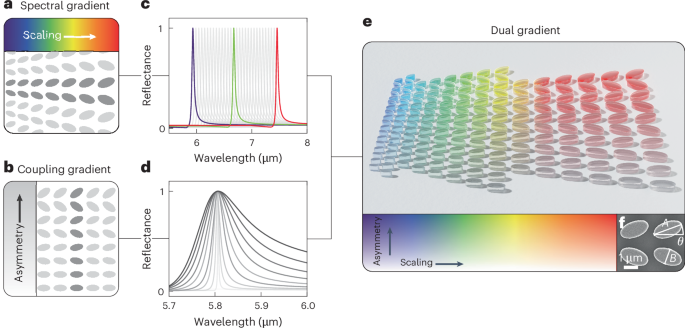Continuous spectral and coupling-strength encoding with dual-gradient metasurfaces
IF 34.9
1区 材料科学
Q1 MATERIALS SCIENCE, MULTIDISCIPLINARY
引用次数: 0
Abstract
To control and enhance light–matter interactions at the nanoscale, two parameters are central: the spectral overlap between an optical cavity mode and the material’s spectral features (for example, excitonic or molecular absorption lines), and the quality factor of the cavity. Controlling both parameters simultaneously would enable the investigation of systems with complex spectral features, such as multicomponent molecular mixtures or heterogeneous solid-state materials. So far, it has been possible only to sample a limited set of data points within this two-dimensional parameter space. Here we introduce a nanophotonic approach that can simultaneously and continuously encode the spectral and quality-factor parameter space within a compact spatial area. We use a dual-gradient metasurface design composed of a two-dimensional array of smoothly varying subwavelength nanoresonators, each supporting a unique mode based on symmetry-protected bound states in the continuum. This results in 27,500 distinct modes and a mode density approaching the theoretical upper limit for metasurfaces. By applying our platform to surface-enhanced molecular spectroscopy, we find that the optimal quality factor for maximum sensitivity depends on the amount of analyte, enabling effective molecular detection regardless of analyte concentration within a single dual-gradient metasurface. Our design provides a method to analyse the complete spectral and coupling-strength parameter space of complex material systems for applications such as photocatalysis, chemical sensing and entangled photon generation. A dual-gradient metasurface is introduced that allows continuous control over light–matter coupling in the spectral and quality-factor parameter space. Used for molecular sensing, it achieves mode densities near the theoretical limit for metasurfaces.


双梯度元曲面的连续谱和耦合强度编码。
要在纳米尺度上控制和增强光与物质的相互作用,两个参数至关重要:光腔模式与材料光谱特征(例如激子或分子吸收线)之间的光谱重叠,以及腔体的品质因数。同时控制这两个参数,就能研究具有复杂光谱特征的系统,例如多组分分子混合物或异质固态材料。迄今为止,我们只能在二维参数空间内对有限的数据点进行采样。在这里,我们介绍一种纳米光子方法,它可以在一个紧凑的空间区域内同时、连续地对光谱和品质因数参数空间进行编码。我们采用的双梯度元表面设计由平滑变化的亚波长纳米声纳器二维阵列组成,每个声纳器都支持基于连续体中对称保护束缚态的独特模式。这样就产生了 27,500 个不同的模式,模式密度接近元表面的理论上限。通过将我们的平台应用于表面增强分子光谱学,我们发现最大灵敏度的最佳品质因数取决于分析物的数量,从而能够在单个双梯度元表面内实现有效的分子检测,而不受分析物浓度的影响。我们的设计为光催化、化学传感和纠缠光子生成等应用提供了一种分析复杂材料系统的完整光谱和耦合强度参数空间的方法。
本文章由计算机程序翻译,如有差异,请以英文原文为准。
求助全文
约1分钟内获得全文
求助全文
来源期刊

Nature nanotechnology
工程技术-材料科学:综合
CiteScore
59.70
自引率
0.80%
发文量
196
审稿时长
4-8 weeks
期刊介绍:
Nature Nanotechnology is a prestigious journal that publishes high-quality papers in various areas of nanoscience and nanotechnology. The journal focuses on the design, characterization, and production of structures, devices, and systems that manipulate and control materials at atomic, molecular, and macromolecular scales. It encompasses both bottom-up and top-down approaches, as well as their combinations.
Furthermore, Nature Nanotechnology fosters the exchange of ideas among researchers from diverse disciplines such as chemistry, physics, material science, biomedical research, engineering, and more. It promotes collaboration at the forefront of this multidisciplinary field. The journal covers a wide range of topics, from fundamental research in physics, chemistry, and biology, including computational work and simulations, to the development of innovative devices and technologies for various industrial sectors such as information technology, medicine, manufacturing, high-performance materials, energy, and environmental technologies. It includes coverage of organic, inorganic, and hybrid materials.
 求助内容:
求助内容: 应助结果提醒方式:
应助结果提醒方式:


